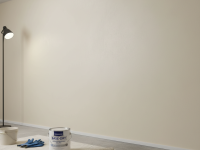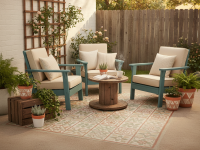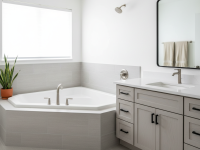Ever dreamt of having your own dedicated fitness sanctuary, a place where you can sweat it out without judgment, anytime you want? We all do! But then reality hits: you look at that “spare room,” and it’s less a grand fitness hall and more… well, a narrow corridor. A storage space in waiting. A place where you wouldn’t even comfortably swing a cat, let alone a kettlebell. If this sounds like you, trust me, I’ve been there.
For years, I put off creating a home gym because I thought my narrow spare room was a deal-breaker. I imagined massive racks and sprawling cardio machines, none of which would ever fit. But after years of squeezing workouts into my living room (and constantly tripping over weights), I decided enough was enough. I was determined to transform that awkward, narrow space into a functional, inspiring home gym. And guess what? It’s not just possible; it’s incredibly rewarding!
This article isn’t just about throwing some equipment into a small room. It’s about smart design, strategic choices, and a shift in mindset to maximize every single inch of your narrow space. Drawing from my own trials and errors, I’m here to share how you can craft a powerhouse gym, even when your room feels more like a hallway.
Understanding Your Space: The First Crucial Step
Before you even think about buying equipment, grab a measuring tape. Seriously, this is crucial. I learned this the hard way by almost buying a treadmill that was just a few inches too long. Measure everything: length, width, ceiling height, and the dimensions of any doors or windows. Pay special attention to the narrowest points and any awkward alcoves.
Once you have your measurements, sketch out a floor plan. You don’t need to be an artist; a simple drawing will do. This visual representation will help you understand the flow of the room and where different pieces of equipment might fit. Consider the path you’ll need to walk, the space required to perform exercises (e.g., lunges, burpees), and how doors will open. My personal trick was to use painter’s tape on the floor to mark out the footprint of potential equipment. It gave me a real-world sense of how much space I actually had.
The Power of Minimalism: Less Is Truly More
When dealing with a narrow space, embracing a minimalist philosophy is your superpower. Forget bulky, single-purpose machines. Your goal is multi-functional, space-saving equipment. My golden rule for small spaces? If it doesn’t serve multiple purposes, fold away, or hang on a wall, think twice. I’ve found that less clutter equals more motivation and more actual space to move.
This doesn’t mean sacrificing your workout. It means being strategic. Instead of a huge dumbbell rack, opt for adjustable dumbbells. Instead of a fixed weight bench, look for a foldable one. Every item you bring into this narrow room needs to earn its place by being highly efficient or easily storable.
Smart Storage Solutions: Keeping Clutter at Bay
Clutter in a small room is not just an eyesore; it’s a safety hazard and a motivation killer. Effective storage is paramount. Since your floor space is limited, think vertically and utilize your walls!
- Wall-Mounted Racks: For resistance bands, jump ropes, yoga mats, or even a small set of lighter dumbbells. Hooks are your best friends.
- Shelving: Floating shelves can hold smaller items like wrist wraps, a timer, or a water bottle, keeping them off the floor.
- Under-Bench Storage: If you have a foldable bench, can you slide a flat storage box underneath it when folded?
- Corner Solutions: A small corner unit can be surprisingly effective for holding a few kettlebells or medicine balls.
- Mobile Carts: A slim, rolling cart can hold various accessories and be tucked away into an unused corner wheot in use.
My top tip here: invest in a good quality wall-mounted pull-up bar. It saves floor space and offers an excellent upper body workout. Just make sure your walls can support it properly!
Equipment Choices for Narrow Spaces: Your Essential Gear Checklist
Forget those massive multi-stations. For my narrow gym, I swear by a curated selection of versatile gear. Here’s what I’ve found to be incredibly effective:
- Adjustable Dumbbells: These are game-changers. One pair can replace an entire rack of traditional dumbbells, saving immense space.
- Resistance Bands: Loop bands, long bands, tube bands – they are lightweight, take up almost no space, and offer a full-body workout.
- Foldable Weight Bench: Essential for chest presses, rows, and various other exercises, but can be folded and tucked away wheot in use.
- Yoga Mat: For floor exercises, stretching, and core work. Can be rolled up and stored in a corner or hung on a hook.
- Jump Rope: Excellent cardio, requires minimal space, and easily stored.
- Kettlebells: A few kettlebells (perhaps one light, one medium, one heavy) offer incredible versatility for strength and conditioning. They are compact compared to barbells.
- Doorway Pull-up Bar: If you can’t install a wall-mounted one, a doorway bar is a fantastic alternative for upper body strength.
The key is to select items that can be used for multiple exercises and, crucially, can be easily stored or moved. You want to avoid any equipment that makes the room feel cramped even wheot in use.
Mirror, Mirror on the Wall: More Than Just Aesthetics
Beyond just checking your form (which is vital, trust me!), mirrors can magically make a small room feel bigger. By reflecting light and the opposite wall, they create an illusion of depth and space. For my narrow gym, a large wall-mounted mirror was one of the best investments. It not only helped me correct my squats and deadlifts but also made the room feel far less claustrophobic. Just be sure to mount it securely!
Lighting and Ambiance: Setting the Mood
A narrow room can easily feel dim and oppressive, which isn’t exactly motivating. Bright, natural-feeling light is crucial. Maximize any natural light you have by keeping windows clear. Supplement with bright LED fixtures. If your room lacks natural light, consider installing brighter ceiling lights or even some strategically placed task lighting.
Don’t forget the ambiance! Your home gym should be a place you *want* to be. A good sound system (even a small Bluetooth speaker), a motivational poster or two, or even a small plant can make a huge difference. I even put up a whiteboard for my workout schedule – it keeps me accountable and adds a personal touch.
Flooring That Works Hard: Protecting Your Investment
This is often overlooked, but don’t skip it! Protecting your existing floor and providing a stable, non-slip surface is essential. I once almost cracked my floor tiles with a dropped dumbbell (oops!), which taught me a valuable lesson. Interlocking rubber mats are perfect for home gyms.
They provide cushioning, absorb impact, reduce noise, and offer grip. You don’t need to cover the entire room; just the area where you’ll be lifting or performing dynamic movements. Measure the area you’ll need and buy enough tiles to cover it. They are relatively inexpensive and can save you a lot of headache (and potential floor damage) in the long run.
The Unsung Heroes: Accessories & Organization
It’s the little things that often make the biggest difference in maintaining an efficient and pleasant workout space. Think about a small towel rack for easy access during sweaty sessions, a wall-mounted water bottle holder, or a simple clock/timer. Keeping these essentials organized and within reach prevents disruption during your workout and ensures a smooth routine. I even added a small, cheap fan – a lifesaver in a confined space!
My Personal Experience: From Hoarder to Hustler
My narrow spare room used to be where old textbooks went to die, alongside random boxes of “stuff I might need someday.” It was intimidating. But by following these steps, starting small, and being patient, I slowly transformed it. I began with just a yoga mat, resistance bands, and a pair of adjustable dumbbells. As I got more comfortable and understood the space better, I added a foldable bench and then a pull-up bar. The key was not to rush but to evolve the space as my needs and understanding grew.
Today, that once-dreaded narrow room is my go-to place for strength training, yoga, and high-intensity interval training. It’s a place where I feel focused, energized, and proud of what I’ve built with limited resources. It proves that limitations often breed the most creative solutions.
Conclusion: Your Dream Gym Awaits, No Matter the Size
Building a home gym in a narrow spare room might seem like a daunting task, but I hope my experience and these tips have shown you that it’s absolutely within reach. It’s not about having the biggest or most expensive equipment; it’s about making smart choices, embracing efficiency, and creating a space that motivates you.
Start with a clear vision, measure everything, invest in multi-functional and storable equipment, and don’t underestimate the power of good lighting and organization. Your narrow room isn’t a limitation; it’s an opportunity to get creative and design a personalized fitness haven that truly works for you. So go ahead, grab that tape measure, and start plaing your powerhouse gym!



